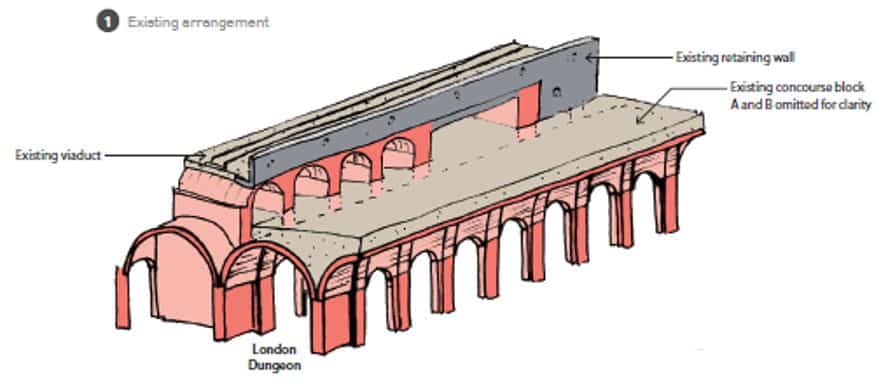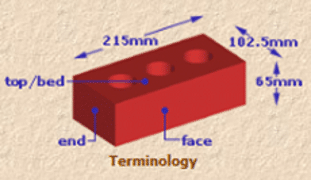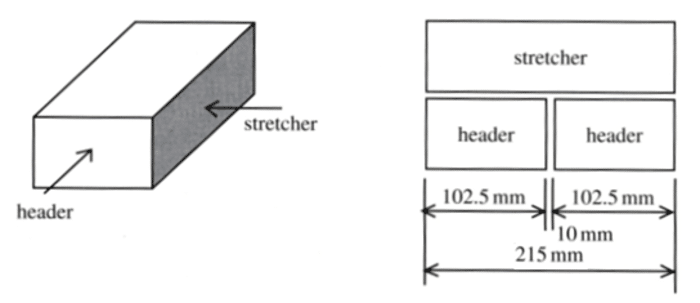Civil's Guide
Masonry
What is Masonry
Masonry is a common building material which refers to the individual units which are laid and bound together by mortar. It is often used for walls of buildings as seen in many parts of the world as it is good in compression but has limited flexural strength.
The main components of any masonry building are found below:
- Masonry Units
- Mortar
- Wall ties
- Damp proof courses
- Reinforcement

Types of masonry units
- Clay bricks – BS EN 771-1:
–Clay, or other argillaceaous material, fired at sufficiently high temperature to achieve a ceramic bond.
- Calcium silicate – BS EN 771-2:
–Lime and sand hardened by high-pressure steam.
- Aggregate concrete blocks – BS EN 771-3:
–Lightweight or normal weight concrete
- Autoclaved aerated concrete blocks – BS EN 771-4:
–Low density blocks, low strength, but good thermal resistance
- Manufactured stone – BS EN 771-5:
–Concrete units made to resemble natural stone
- Natural stone – BS EN 771-6:
–Natural stone cut to required shape. Properties determined by tests
Types of Bricks
There are literally thousands of different bricks – reduce basic types. The vast majority are made from clay and are kiln-fried.
Facing Bricks
Quality, durable bricks with an attractive appearance for external use above ground.
Wirecut
The clay is continuously extruded to a required size and shape and then cut into individual bricks by means of awire. Usually the cheapest facings available since the manufacturing process is highly automated.
Engineering
The workhorses of the brick family. Tough, strong, hard-wearing but not usually very pretty. Excellent resistance to frost & water, ideal for groundworks, sewer works, retaining walls.
Clay bricks
Clay brick densities range from 22 – 28 kN/m3 and be either hand made or factory made.
Engineering bricks is defined by 2 categories
- Class A strength > 70 N/mm2; water absorption < 4.5% by mass.
- Class B strength > 50 Nmm2; water absorption < 7.0% by mass.
Calcium Silicate Bricks
This type of brick is popular in areas where good brick making clay is scarce and a lot cheaper in comparison. Densities are lower and range from 17-21 kN/m3.
Concrete Blocks
These are cement bound blocks which has a high range of densities depending on what aggregates are used. The density ranges from 5 to 20 kN/m3
Brick Dimensions
The UK modular format: standard brick size 215×102.5×65 mm (face x bed x end). With a standard 10 mm wide joint, gives a working size of 225mm x 75 mm.
4 courses of bricks (+bedding joints) gives a total depth of 300 mm. 4 bricks in a line gives a width of 900mm including the perpends (vertical joints)
Using stretcher bond, there are 60 bricks/m2 in a single skin wall.


Cement mortar mixes for masonry
| Compressive Strength class | Compressive strength \(f_m\) | Mortar class | Mortar constituents and proportions | |||
|---|---|---|---|---|---|---|
| Cement:Lime:Sand | Cement:Sand | Masonry \(Cement^a\):Sand | Masonry \(Cement^b\):Sand | |||
| M12 | 12 N/mm2 | (i) | 1:0:3 to 1:\(\frac{1}{4}\):3 | 1:3 | ||
| M6 | 6 N/mm2 | (ii) | 1:\(\frac{1}{2}\):4 to 1:\(\frac{1}{2}\):4\(\frac{1}{2}\) | 1:3 to 1:4 | 1:2\(\frac{1}{2}\) to 1:3\(\frac{1}{2}\) | 1:3 |
| M4 | 4 N/mm2 | (iii) | 1:1:5 to 1:1:6 | 1:5 to 1:6 | 1:4 to 1:5 | 1:3\(\frac{1}{3}\) to 1:4 |
| M2 | 2 N/mm2 | (iv) | 1:1:8 to 1:1:9 | 1:7 to 1:8 | 1:5\(\frac{1}{2}\) to 1:6\(\frac{1}{2}\) | 1:4\(\frac{1}{2}\) |
(a) Sulphate resisting mortar is advised where soluble sulphates are expected from the ground, saturated bricks or elsewhere.
(b) F indicates that the bricks are frost resistant, M indicates moderate frost resistance and 0 indicates no frost resistance.
(c) N indicates thatthe bricks have normal soluble salt content and L indicates low soluble salt content.
(d) Retaining walls planter boxes should waterproofed on their retaining faces to improve durability and prevent staining.
Movement joints in brickwork
| Material | Approximate horiozntal joint spacing and reason for provision | Typical joint thickness (mm) | Maximum suggested panel length: Height ratio |
|---|---|---|---|
| Clay bricks | 12m for expansion | 16 | 3:1 |
| 15-18m with bed joint reinforcement at 450 mm c/c | 22 | ||
| M12 | 18-20m with bed joint reinforcement at 225 mm c/c12 N/mm2 | 25 | |
| Calcium silicate bricks | 7.5 – 9 m for shrinkage | 10 | 3:1 |
| Concrete blocks | 6-7m for shrinkage | 10 | 2:1 |
| 15-18m with bed joint reinforcement at 450 mm c/c | 22 | ||
| 18-20m with bed joint reinforcement at 225 mm c/c | 25 | ||
| Natural stone cladding | 6m for thermal movements | 10 | 3:1 |
